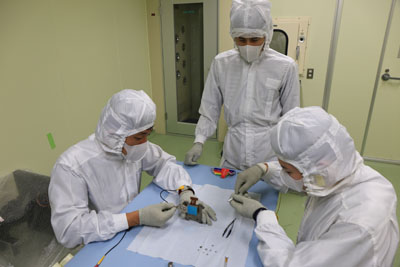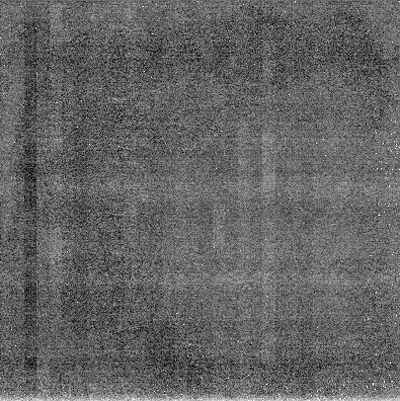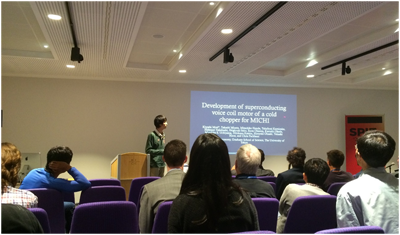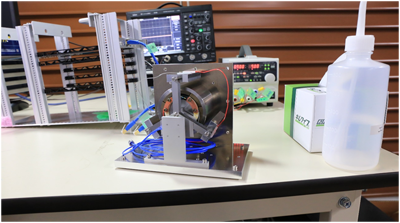
|
Two graduate students received master’s degree related to the development of instrument for the TAO telescope!
Two graduate students from the Department of Astronomy, the University of Tokyo, Yasunori Terao and Kiyoshi Mori, successfully completed their master’s degrees. They served as key development members of the 1st-generation instruments for the TAO 6.5m telescope "Near-infrared multi-object spectrograph SWIMS" and "Mid-infrared Multi-mode Imager MIMIZUKU". This article presents their research achievements, the result of two years of dedicated effort.
Development of a detector system for SWIMS, Simultaneous-color Wide-field Infrared Multi-object Spectrograph
Department of Astronomy, Graduate School of Science, the University of Tokyo, Master's Course
Yasunori Terao
|
During the two years of my master's course, I developed and evaluated the detector system of the near-infrared instrument SWIMS and summarized the results in my master's thesis. SWIMS is one of the first-generation instruments for the TAO 6.5m telescope, which can observe two near-infrared wavelength ranges simultaneously by splitting the incident light into two, 0.9--1.4 microns and 1.4--2.5 microns. Each split near-infrared light passes through a separate optical path and forms an image on detectors mounted on the focal plane. With features such as a wide field of view, highly efficient observation, and an integral field spectroscopy mode, SWIMS is expected to realize various observations and produce many scientific achievements.
SWIMS is equipped with four HAWAII-2RG (H2RG) detector arrays, two for the short wavelengths and two for the long wavelengths (four each for a total of eight in the future). It is necessary for the four detectors to operate simultaneously to observe a wide field of view at the same time. There is a dedicated software that runs on a Windows OS to control a H2RG. On the other hand, since SWIMS (as a whole system) is controlled by a single Linux PC, we need to build a control system for H2RGs to drive simultaneously which can be integrated into the whole system. We realized the control system by launching a Windows virtual machine on Linux for each H2RG and sending control commands to the dedicated software via socket communication.
In addition, detectors must always meet performance requirements on noise for scientific observations. As a ground-based instrument, SWIMS requires that dark current and readout noise must be less than the Poisson noise of the sky background light (which is called 'background-limit'). Dark current is a noise source caused by electrons excited by thermal motion in the detector semiconductor, and readout noise is one generated in an electrical circuit during readout. We found that driving multiple H2RGs simultaneously increases the readout noise by more than three times compared to when driving only one H2RG. It was caused by interference between the cables connecting the circuits that read the H2RG, and was mitigated by adding shielding to the cables. There is another factor that increases readout noise when driving multiple H2RGs simultaneously, and it was solved by changing parameters for driving the H2RGs. With these efforts, we completed a detector control system that achieves the required noise performance for SWIMS.
The basic premise of a detector, from a user’s point of view, is that it works properly, and the noise elimination works in my thesis are like turning a negative into a zero. Since the cause of the increased noise may be present in unexpected places, it is essential to repeat every trial and error we can think of. Looking back on the detector tests so far, I have to admit that they have been more painful than enjoyable. However, when stubborn noise patterns have finally disappeared, I had experienced the unforgettable moment of feeling the joy of seeing an image without any stars. I would be more than happy to have the opportunity to use SWIMS in the future for observational studies of distant galaxies that interest me. During the next three years of the Ph.D program, I would like to make successful engineering observations of SWIMS on the Subaru Telescope and to produce scientific results that will lead to the future.

▲The detector installation work (The author is on the right.)

▲Noise image (taken without light) when multiple detectors are driven simultaneously.
|
Development of superconducting linear motors for cold choppers in next-generation mid-infrared instruments
Kiyoshi Mori
Master's Course in Department of Astronomy, Graduate School of Science, the University of Tokyo
|
In my master’s thesis, I developed superconducting linear motors for the cold chopping system in MIMIZUKU, one of the first-generation instruments currently being developed for the TAO telescope. Since MIMIZUKU can see infrared light emitted not only from celestial objects distant in space, but also from the environment in which we normally live on Earth, such as the atmosphere, the ground, and even human bodies, we need a method to extract only the light from celestial objects in observations. The technique used for this extraction is called chopping. Specifically, we first observe the sky area where the target object exists (we see light from both the target and other sources), and then quickly move a mirror to change the observed sky region and observe only the light from sources other than the target. If we take these differences, we get just the light from the target. There are various opinions as to the origin of the name, 'chopping,' but it seems to come from the quick movement of the mirror, which looks like the action of cutting an object into small pieces (chopping).
In conventional mid-infrared observations, chopping was performed by moving the telescope's secondary mirror quickly. However, as telescopes get larger, it becomes more difficult to move the secondary mirror quickly. For example, the 8.2-m Subaru Telescope has a 1.3-m secondary mirror which can be moved only once per second. The next-generation 30-m telescope (TMT) will have a 3.1-m secondary, making it nearly impossible to move it quickly. Therefore, a new method called ‘internal chopping’, in which a mirror inside the instrument is moved, is being studied. In mid-infrared instruments, the mirror on the optics is cooled to -253 degrees Celsius or lower to prevent light emission from the mirror itself. For this reason, internal chopping is also called ‘cold chopping’. This study on cold chopping is not only for MIMIZUKU of the TAO project, but also has a challenging aspect of demonstrating the basic technology needed for the next-generation 30-m telescope.
As the name implies, cold chopping is performed in a low-temperature environment of -253 degrees Celsius or lower, it is extremely important to keep the heat generation small. With conventional technologies, it has been difficult to quickly move the mirror while suppressing heat generation, but this research has shown that heat generation can be suppressed to 1/10 of the conventional level by using a superconducting material called magnesium diboride (MgB2). Although we have to wait for a demonstration test to see if it can actually be used, we are now much closer to the realization of cold chopping, which has been difficult to achieve.
Professor Hiroyuki Osaki of Graduate School of Frontier Sciences, the University of Tokyo helped us in using superconducting material. You may think that superconducting has nothing to do with astronomy, however, such collaboration and cooperation with other fields has steadily produced positive results, and I myself have received many positive stimuli. We look forward to the day when we can create an even better instrument by deepening our collaboration and cooperation with other fields in the future.

▲The author made a presentation at the SPIE conference (international conference on instrumentation) in Edinburgh.

▲Superconducting linear motor designed and assembled by the author.
|
|





